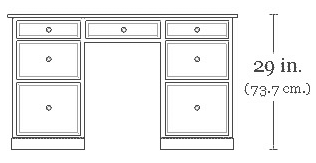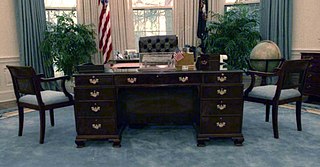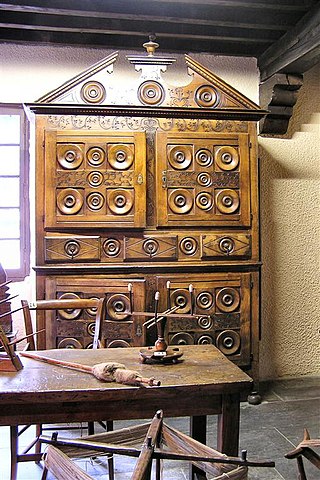
A pedestal desk or a tanker desk is usually a large, flat, free-standing desk made of a simple rectangular working surface resting on two pedestals or small cabinets of stacked drawers of one or two sizes, with plinths around the bases. Often, there is also a central large drawer above the legs and knees of the user. Sometimes, especially in the 19th century and modern examples, a "modesty panel" is placed in front, between the pedestals, to hide the legs and knees of the user from anyone else sitting or standing in front. This variation is sometimes called a "panel desk". The smaller and older pedestal desks with such a panel are sometimes called kneehole desks, they were intended for small spaces like boudoirs and were usually placed against a wall. The kneehole desks are also known as bureau tables.

A writing table has a series of drawers directly under the surface of the table, to contain writing implements, so that it may serve as a desk. Antique versions have the usual divisions for the inkwell, the blotter and the sand or powder tray in one of the drawers, and a surface covered with leather or some other material less hostile to the quill or the fountain pen than simple hard wood.

The slant-top desk, also called secretary desk, or more properly, a bureau, is a piece of writing furniture with a lid that closes at an angle and opens up as a writing surface. It can be considered related, in form, to the desk on a frame, which was a form of portable desk in earlier eras.

There are two kinds of trestle desk: as with trestle tables, some have trestles joined by one or more stretchers, and some have free-standing trestles. They can be dismantled, with the desk top removed from the trestles, for storage or transport.

A partners desk, partner's desk or partners' desk is a mostly historical form of desk, a large pedestal desk designed and constructed for two users working while facing each other. The defining features of a partner's desk are a deep top, two sets of drawers, one at each end of the pedestal.

A Davenport desk, is a small desk with an inclined lifting desktop attached with hinges to the back of the body. Lifting the desktop accesses a large compartment with storage space for paper and other writing implements, and smaller spaces in the forms of small drawers and pigeonholes. The Davenport has drawers on one of its sides, which are sometimes concealed by a panel. This stack of side drawers holds up the back of the desk and most of its weight.
The fire screen desk is a very small antique desk form meant to be placed in front of a fireplace to keep a user's feet warm while he or she is stationary while writing. This kind of desk was very popular in prosperous homes in Europe during the 18th century and slowly disappeared during the 19th, with the gradual introduction of stoves and central heating.

A Carlton House desk is a specific antique desk form within the more general bureau à gradin form. This form of desk is supposed to have been designed in the 18th century for the Prince of Wales by George Hepplewhite. It is named after Carlton House, which was at the time the London residence of the Prince, and sometimes is also known as a Carlton House writing table.

A commode is any of many pieces of furniture. The Oxford English Dictionary has multiple meanings of "commode". The first relevant definition reads: "A piece of furniture with drawers and shelves; in the bedroom, a sort of elaborate chest of drawers ; in the drawing room, a large kind of chiffonier." The drawing room is itself a term for a formal reception room, and a chiffonier is, in this sense, a small sideboard dating from the early 19th century.

A tallboy is a piece of furniture incorporating a chest of drawers and a wardrobe on top. A highboy consists of double chest of drawers, with the lower section usually wider than the upper. A lowboy is a table-height set of drawers designed to hold a clothes chest, which had been the predominant place one stored clothes for many centuries.

A Murphy bed is a bed that is hinged at one end to store vertically against the wall, or inside a closet or cabinet. Since they often can be used as both a bed or a closet, Murphy beds are multifunctional furniture.

A table is an item of furniture with a raised flat top and is supported most commonly by 1 to 4 legs. It is used as a surface for working at, eating from or on which to place things. Some common types of tables are the dining room tables, which are used for seated persons to eat meals; the coffee table, which is a low table used in living rooms to display items or serve refreshments; and the bedside table, which is commonly used to place an alarm clock and a lamp. There are also a range of specialized types of tables, such as drafting tables, used for doing architectural drawings, and sewing tables.

A chest of drawers, also called a dresser or a bureau, is a type of cabinet that has multiple parallel, horizontal drawers generally stacked one above another.

A lowboy is an American collectors term for one type of dressing table. It is a small table with one or two rows of drawers, so called in contradistinction to the tallboy or highboy chest of drawers.

The Antique Furnishings & Wooden Sculpture Museum of Milan is located on the first floor of the Sforza Castle ducal courtyard and it is part of the Sforza Castle's Civic Museum complex.

The Memphis Group, also known as Memphis Milano, was an Italian design and architecture group founded by Ettore Sottsass. It was active from 1980 to 1987. The group designed postmodern furniture, lighting, fabrics, carpets, ceramics, glass and metal objects.

A toilet service is a set of objects for use at the dressing table. The term is usually reserved for large luxury sets from the 17th to 19th centuries, with toilet set or vanity set used for later or simpler sets. Historically, services were made in metal, ceramics, and other materials, for both men and women, though male versions were generally much smaller. The rich had services in gold, silver, or silver-gilt. The contents vary, but typically include a mirror, one or more small ewers and basins, two candlesticks, and an assortment of bowls, boxes, caskets, and other containers. One or more brushes and a pin-cushion, often as a top to a box, are often included. The sets usually came with a custom-made travelling case, and some services were especially designed for travelling.

The furniture of the Louis XV period (1715–1774) is characterized by curved forms, lightness, comfort and asymmetry; it replaced the more formal, boxlike and massive furniture of the Louis XIV style. It employed marquetry, using inlays of exotic woods of different colors, as well as ivory and mother of pearl.

Louis XVI furniture is characterized by elegance and neoclassicism, a return to ancient Greek and Roman models. Much of it was designed and made for Queen Marie Antoinette for the new apartments she created in the Palace of Versailles, Palace of Fontainebleau, the Tuileries Palace, and other royal residences. The finest craftsmen of the time, including Jean-Henri Riesener, Georges Jacob, Martin Carlin, and Jean-François Leleu, were engaged to design and make her furniture.



























